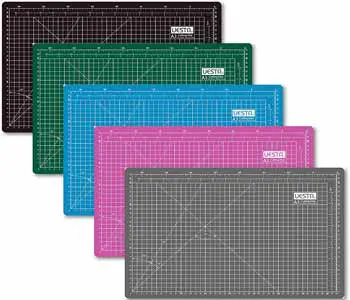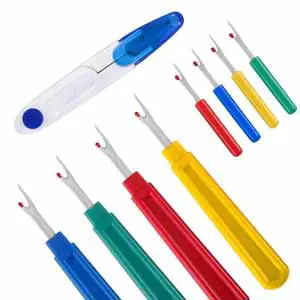Top 10 Quilting Tools That Every Quilters Needs
Did you know that there are more than 7 million quilters in the US alone? Plus, households with dedicated quilters spend more than $500 a year on buying quilting supplies. And these are just numbers from research conducted in 2017. They might be higher as of this writing.
If you are one of the dedicated quilters, you most probably have a set of tools to help you with your favorite activity. But if you are getting started, you need to be well equipped before you can start quilting.
So, what are the must-have tools for a quilter? Let’s find that out, shall we?
Table of Contents
1. Rotary Cutters [and replacement blades]

One of the most essential tools to have as a quilter is a rotary cutter. Quilting requires accurate cutting, which can only be achieved using a rotary cutter. Rotary cutters for general quilting come with two standard sizes; which are the 45mm and 60mm blades. You must try each size by visiting a quilt shop near you. It is best to know how one feels in your hand before buying it. Ensure that it is comfortable enough.
Some users prefer using the larger 60mm for cutting through several layers, while others opt for the smaller 45mm blade. However, you can find smaller blades of 18mm and 28mm, especially if you will be cutting appliqué shoes.
Keep in mind that when you cut the quilts accurately, you will also have an accurate piecing. It is all about mastering the skill of cutting the quilts precisely. If you can cut the quilts accurately without any problem, you will be able to chain-piece quickly in the end.
For the best cutting, ensure that you buy some extra replacement blades, which will assure you of reliable cutting experience. Plus, when you have different decorative blades, you can do some fun finishes on your fabrics.
Generally, the rotary cutter will resemble a pizza cutter. It comes with super-sharp blades, which must be handled with care.
2. Self-Healing Cutting Mats

Usually, rotary cutters will be used along with self-healing cutting mats. The reason for using these unique mats is to protect the surface that you are working on as you use the rotary cutter. The best thing about the self-healing mats is that they will remain strong after years of use. Plus, the cuts will not leave indentations on the surface.
Ideally, always go for the most extensive cutting mat that will give you enough space. This way, you can spread your fabric wide enough without worrying about your table or counter.
For example, the most common size of a cutting mat is 24 by 36 inches. This mat is big, and it fits comfortably on a small working table. You’ll also get enough room for cutting your fabric. The 18 by 24 mat is much smaller, but can also be reliable if you don’t have large fabrics to cut.
Some cutting mats also come with an ironing board on the back with offers a dual tool.
3. Scissors

Without any doubt, you will need a proper pair of scissors to help you when you need to cut those fabrics. Keep in mind that a pair of scissors and a rotary cutter performs differently. Scissors and shears are interchangeable because they work the same.
However, rotary cutters are different, and they should never be confused with shears or scissors. One significant difference is that shears or scissors are easily portable and can be used freely without the need for a cutting mat. Rotary cutters are best used for cutting straight lines, several layers of fabric and are only used with a cutting mat.
Here is a guide to help you decide when you should use scissors or a rotary cutter.
Scissors are supposedly the most common cutting options because even beginners can use them. They can either be small or large (shears).
Small Scissors

If you are working on handwork and some small projects, small scissors will be the right choice for you. They are easily portable, and they come in handy when you need to clip threads or snip some tiny bits of the fabric. Ensure that the handle is comfortable enough and that the tip is pointy to let you get into tight spaces with ease.
Shears

Shears are large, and you can use more than one finger on the handle. You can use them for cutting around templates and even getting into areas that the rotary cutters cannot reach. But you should avoid using the fabric shears for paper crafts or for cutting other stuff in the house. Doing so will make them dull too quickly. Dull blades would be more difficult to cut the thread and fabric. Ensure that you use the shears only for cutting fabric.
Again, the fabric shears you choose must come with a comfortable handle.
4. Seam Rippers

The seam rippers are used for undoing the stitches. Sometimes, the seam ripper might come with the sewing machine. But since you are getting started, you should consider getting a seam ripper just in case you will need to remove the stitches. Some seam rippers come with large and comfortable handles for better handling.
5. Acrylic Quilting Ruler

An acrylic cutting ruler will help when you need to make straight cuts on your fabric. They are generally transparent and come with some gripping to prevent them from slipping. A quilting ruler will be used with the rotary cutter when you want to make straight and accurate cuts.
For a beginner, a 5inch by 34inch (Dritz) or the 6inch by 24inch (Omnigrip) ruler are the best to start with.
6. Sewing machine

A sewing machine is a must-have as you are getting started with your quilting. You don’t have to go for the advanced machine. Instead, a basic unit is good enough. Ensure that you pick a high-quality quilting sewing machine that is reliable enough to serve you accordingly. Don’t forget to buy one that falls in your budget.
If you are not good at sewing the fabrics, you can always start with scrap fabrics until you get good at it. In most cases, the machines will come with a special 0.24-inch foot to help you along with the process.
But you will want to ensure that there is a walking foot to help you with your own quilts. A walking foot is used to prevent the fabric from shifting whenever your quilt goes through many layers as you apply the binding.
On the other hand, a darning or free-motion foot sews freehand designs onto a quilt.
Check out this amazing video from a quilting expert to help you find the right sewing machine for quilting.
7. Fabric/Thread

Obviously, you must budget for the right fabric for quilting along with high-quality threads. Most quilters go for the 50-weight cotton or poly-cotton blend of thread for basic piecing. Any other thread weight can be used for appliqué, decorative stitches, as well as binding. Always ensure you buy different types of threads to see which one suits your machine best.
8. Pins/Pincushion

The sewing pins that you use must be sharp and sturdy enough. Also, you should use either a magnetic pin bowl or a pincushion to sore them safely and quickly.
Pins can help you achieve accuracy with your quilting as you are piecing. They help to hold fabrics together for sewing. Luckily, these pins are sharp and easy to glide smoothly through fabrics, given the fact that they come with a comfortable head for pushing them through the fabric.
9. Iron and Ironing Board

The iron you buy should be used to straighten your fabric when needed. The ironing board helps to offer a stable surface for ironing the fabrics. The iron will mostly be sued after your pieces are complete.
10. Clips

You also need little clips for securing the binding and also finishing your quilt. Furthermore, these clips are a great alternative to pins when working with multiple fabric layers. If you are making bags or other home accessories, the clips can come in handy. You may also use them to hold blocks and block pieces together. This way, you can be sure that your pieces won’t be out of order or misplaced.
Other supplies/tools needed
Besides the listed tools for quilting, there are some other supplies that you may need in your crafting. Here is a look at them:
Conclusion
Always ensure that you do a rough design of how you intend your quilt to appear before you start working on them. Above all, keep in mind that practice makes perfect. Remember that there are some tools that can be used as supplements of others.
For instance, you can use scissors in the place of a rotary cutter. But don’t forget that rotary cutters are the best for making straight and accurate lines, as well as cutting several layers of fabrics.
If you have an issue when picking the right tool to get started with your quilting, always ask a professional to help you choose the most relevant tools. Plus, ensure that you take good care of your tools for them to serve you for a long time.

